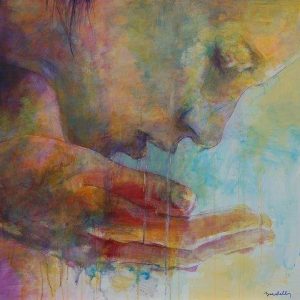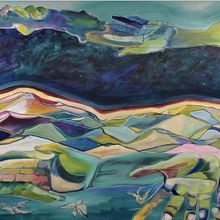 Our Moving into Meditation class continues to draw inspiration from The Five Invitations, Frank Ostaseski’swonderful book about living with the awareness that we’re going to die. His book distills what he’s learned into Five Invitations we can answer in living a conscious life in connection with each other. In today’s class we continued working with the fourth invitation: to find a place of rest in the middles of things. We also drew inspiration from Poet, peace activist and meditation teacher Thich Nhat Hanh who is affectionately referred to as Thay by his many students. Nearly all of his teachings on mindfulness emphasize living in the present moment – the gateway to inner peace. Both teachers emphasize the importance of relaxing into the present moment so that we can allow life to unfold and lessen our habitual struggles. Continue reading
Our Moving into Meditation class continues to draw inspiration from The Five Invitations, Frank Ostaseski’swonderful book about living with the awareness that we’re going to die. His book distills what he’s learned into Five Invitations we can answer in living a conscious life in connection with each other. In today’s class we continued working with the fourth invitation: to find a place of rest in the middles of things. We also drew inspiration from Poet, peace activist and meditation teacher Thich Nhat Hanh who is affectionately referred to as Thay by his many students. Nearly all of his teachings on mindfulness emphasize living in the present moment – the gateway to inner peace. Both teachers emphasize the importance of relaxing into the present moment so that we can allow life to unfold and lessen our habitual struggles. Continue reading
Waves Below the Surface
 Our Moving into Meditation class continues to draw inspiration from The Five Invitations, Frank Ostaseski’s wonderful book about living with the awareness that we’re going to die. His book distills what he’s learned into Five Invitations we can answer in living a conscious life in connection with each other. In today’s class we explored the fourth invitation: to find a place of rest in the middles of things. Frank advises that: “. . . If we hope to find true rest, we need to see clearly the currents that disturb us. . . To make real change, we have to dive deeper to understand the specific ways that we’ve been conditioned throughout our lives.” Our mindfulness practice offers us the time and space to understand our conditioning and how it drives us to distress. Continue reading
Our Moving into Meditation class continues to draw inspiration from The Five Invitations, Frank Ostaseski’s wonderful book about living with the awareness that we’re going to die. His book distills what he’s learned into Five Invitations we can answer in living a conscious life in connection with each other. In today’s class we explored the fourth invitation: to find a place of rest in the middles of things. Frank advises that: “. . . If we hope to find true rest, we need to see clearly the currents that disturb us. . . To make real change, we have to dive deeper to understand the specific ways that we’ve been conditioned throughout our lives.” Our mindfulness practice offers us the time and space to understand our conditioning and how it drives us to distress. Continue reading
Spaciousness in Life
 Our Moving into Meditation class draws inspiration from hospice counselor and author Frank Ostaseski and poets David Whyte and Mary Oliver. British-American poet, David Whyte is a Whidbey Island local who also works to connect people in the workplace through his organization, The Institute for Conversational Leadership. He is a most inspiring speaker you can hear his TED talk, A Lyrical Bridge Between Past Present and Future. Mary Oliver is a treasured American poetic voice who won the Pulitzer Prize for her work in 1984 for her book of poems, American Primitive. Both poets convey an evocative, poignant sense of being in those moments in which time seems suspended. Their work surfaces in a spaciousness that allows for connection and creativity. Cultural anthropologist and writer, Angeles Arrien, added her perspective on the essential experience of rest in our lives.
Our Moving into Meditation class draws inspiration from hospice counselor and author Frank Ostaseski and poets David Whyte and Mary Oliver. British-American poet, David Whyte is a Whidbey Island local who also works to connect people in the workplace through his organization, The Institute for Conversational Leadership. He is a most inspiring speaker you can hear his TED talk, A Lyrical Bridge Between Past Present and Future. Mary Oliver is a treasured American poetic voice who won the Pulitzer Prize for her work in 1984 for her book of poems, American Primitive. Both poets convey an evocative, poignant sense of being in those moments in which time seems suspended. Their work surfaces in a spaciousness that allows for connection and creativity. Cultural anthropologist and writer, Angeles Arrien, added her perspective on the essential experience of rest in our lives.
Love Has Been Here All Along
 Our Moving into Meditation class draws inspiration from hospice counselor and author Frank Ostaseski and poets Pablo Neruda and Rabindranath Tagore. Frank’s compassionate voice is joined by Neruda’s experience of social activism in 1920’s Chile and later exile. Tagore lived during India’s colonization under the British. He was a prolific writer, composer and educational reformer. Both these creative geniuses won the Nobel Prize for literature. Past and present voices encourage us to keep our hearts open and realize our deepest humanity. Continue reading
Our Moving into Meditation class draws inspiration from hospice counselor and author Frank Ostaseski and poets Pablo Neruda and Rabindranath Tagore. Frank’s compassionate voice is joined by Neruda’s experience of social activism in 1920’s Chile and later exile. Tagore lived during India’s colonization under the British. He was a prolific writer, composer and educational reformer. Both these creative geniuses won the Nobel Prize for literature. Past and present voices encourage us to keep our hearts open and realize our deepest humanity. Continue reading
River of Feeling
Our Moving into Meditation class continues to draw inspiration from hospice counselor and author Frank Ostaseski and poets Danna Faulds and Thich Nhat Hanh. Danna is the other of six books of poetry. You can find more of her inspiration at her Kripalu Center staff site.
Poets and healers seem to convey the “suchness” of meditation by painting auditory images that evoke feelings beyond words.
Making Peace With Your Mind
 Our Moving into Meditation class continues to draw inspiration from Frank Ostaseski’s The Five Invitations, a wonderful book about “what death can teach us about living fully.” If you would like to learn more about Frank – his moving personal history – and his book, you can read Maria Popova’s Brain Pickings article, The Five Invitations: Zen Hospice Project Co-founder Frank Ostaseski on Love, Death and the Essential Habits of Mind for a Meaningful Life. We also drew from Mark Coleman’s book, Make Peace With Your Mind. Mark is a mindfulness teacher, wilderness guide and author. Both works focus, in part, on self judgment. They offer insights and practices on how to free ourselves from the inner critic that drains our lives of joy and spontaneity.
Our Moving into Meditation class continues to draw inspiration from Frank Ostaseski’s The Five Invitations, a wonderful book about “what death can teach us about living fully.” If you would like to learn more about Frank – his moving personal history – and his book, you can read Maria Popova’s Brain Pickings article, The Five Invitations: Zen Hospice Project Co-founder Frank Ostaseski on Love, Death and the Essential Habits of Mind for a Meaningful Life. We also drew from Mark Coleman’s book, Make Peace With Your Mind. Mark is a mindfulness teacher, wilderness guide and author. Both works focus, in part, on self judgment. They offer insights and practices on how to free ourselves from the inner critic that drains our lives of joy and spontaneity.
Living Wholeness
 Our Moving into Meditation class continues to draw inspiration from The Five Invitations, Frank Ostaseski’s wonderful book about living a conscious, loving life knowing that one day we will die. Frank is the cofounder of the Zen Hospice Project and Metta Institute. Frank shares about his own close brush with death. He experienced intense dependence and vulnerability during his recovery. The loving kindness and support he received from others helped him to live in wholeness.
Our Moving into Meditation class continues to draw inspiration from The Five Invitations, Frank Ostaseski’s wonderful book about living a conscious, loving life knowing that one day we will die. Frank is the cofounder of the Zen Hospice Project and Metta Institute. Frank shares about his own close brush with death. He experienced intense dependence and vulnerability during his recovery. The loving kindness and support he received from others helped him to live in wholeness.
Living wholeness inspired our Guided Relaxation:
As we are gradually coming to touch the silence within . . . living from the silence within, we come to know our wholeness . . . a wholeness that it is limitless, eternal, trustworthy, joyous, compassionate, loving and real. Feeling breathing we touch the trustworthy . . . Senses sensing . . . the compassionate, loving and real . . . this experience of being . . .
Here we are together . . . exploring being, sharing being . . . It is up to us to live our life in wholeness … to turn to it, and grasp it, through conscious living. . . . Yet often this living wholeness seems to fall through our fingers like sand . . . or water we cup in our hands . . . the drops and grains lost in whispers of self doubt . . . judgments about how we are flawed . . . or not enough . . .
Imagine yourself as a big jigsaw puzzle . . . thousands of pieces making the whole . . . what pieces would you leave out. . . . How many pieces would you discard before you are looking at a fragmented image?
Rest in Love Meditation
 Our Moving into Meditation class continues at Yoga Bliss. Over the next few weeks we’ll draw inspiration from The Five Invitations, Frank Ostaseski’s wonderful book about living with the awareness that we’re going to die: “an ever-present consciousness of death can bring us closer to our truest selves” Frank is the cofounder of the Zen Hospice Project and Metta Institute. He has spent years being tenderly present with people during their most vulnerable moments. His book distills what he’s learned into five invitations we can answer in living a conscious life in connection with each other.
Our Moving into Meditation class continues at Yoga Bliss. Over the next few weeks we’ll draw inspiration from The Five Invitations, Frank Ostaseski’s wonderful book about living with the awareness that we’re going to die: “an ever-present consciousness of death can bring us closer to our truest selves” Frank is the cofounder of the Zen Hospice Project and Metta Institute. He has spent years being tenderly present with people during their most vulnerable moments. His book distills what he’s learned into five invitations we can answer in living a conscious life in connection with each other.
The Five Invitations:
- Don’t Wait
- Welcome Everything, Push Away Nothing
- Bring Your Whole Self to the Experience
- Find a Place of Rest in the Middle of Things
- Cultivate Don’t Know Mind
Greening of the Self in Meditation
 This month, our Moving into Meditation class is focusing on the Yoga Ethic of Isvara-Prañidhânâ: surrendering to one’s highest ideal. This practice of devotion is a path to realizing Samadhi – the state of perfected concentration or the deep absorption of meditation.
This month, our Moving into Meditation class is focusing on the Yoga Ethic of Isvara-Prañidhânâ: surrendering to one’s highest ideal. This practice of devotion is a path to realizing Samadhi – the state of perfected concentration or the deep absorption of meditation.
Patanjali’s Yoga Sutra:
PYS II.45 samâdhi-siddhir îsvara-prañidhânât
From an attitude of letting go into one’s source (ishvarapranidhana), the state of perfected concentration (samadhi) is attained.
samâdhi = oneness, integration
siddhiï = perfection
îsvara = divine ideal of pure awareness
prañidhânât = surrender, dedication, application, alignment
In our group practice I invited students to surrender the sense of separate self to explore an interdependent being with the web of life. From an attitude of letting go into this state of inter-being we might realize Samadhi. We drew on the work of eco-philosopher, Joanna Macy – particularly her wonderful book: World as Lover World as Self.
Listening Ourselves Into Being
Our Moving into Meditation class continues to focus on the Yoga Ethic of Svadhyaya or “self-study.” Self-reflection involves listening to ourselves and also listening to each other. In his latest book, The Lost Art of Conversation, Tibetan Buddhist scholar, teacher and writer Sakyong Mipham Rinpoche encourages us to approach listening as a form of auditory meditation. He writes:
“When we practice meditation, we strip away the words and come to an inexpressible experience of our own being that happens only when we let ourselves relax, feel who we are, and be there for it. . . . when we feel who we are in our hearts, then no matter what experience we are having, we are staying . . .
Meditation . . . allows us to rest in our own vulnerability and strength. . . . The first step is to allow ourselves just to feel. In feeling, there is a sense of unknowing and knowing. Instead of relating to it as a minor sensation, connect to your sense of feeling as a sign that you are alive.
. . . Equanimity toward what is happening engenders a quality of steadiness, and at the same time frees you to . . . move . . . into the space of possibility.”


